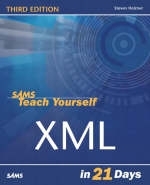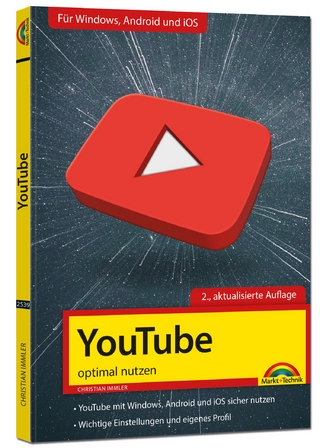
Sams Teach Yourself XML in 21 Days
Sams Publishing (Verlag)
978-0-672-32576-2 (ISBN)
- Titel ist leider vergriffen;
keine Neuauflage - Artikel merken
Sams Teach Yourself XML in 21 Days, written by expert author Steve Holzner, offers hundreds of real-world examples demonstrating the uses of XML and the newest tools developers need to make the most of it. In Week One, he starts from basic syntax, and discusses XML document structure, document types, and the benefits of XML Schema. Week Two covers formatting using either CSS or the Extensible Sytlesheet Language, and working with XHTML and other tools for presenting XML data on the Web, or in multimedia applications. The final chapter of week two discusses XForms, the newest way to process forms in XML applications. Week Three applies XML to programming with Java, .NET or JavaScript, and building XML into database or Web Service applications with SOAP. Along the way, Steve shows readers the results of every lesson and provides both the "how" and "why" of the inner working of XML technologies.
Steven Holzner is an award-winning author who has written 80 computing books. He has been writing about XML since it first appeared and is one of the foremost XML experts in the United States, having written several XML bestsellers and being a much-requested speaker on the topic. He's also been a contributing editor at PC Magazine, has been on the faculty of Cornell University and MIT, and teaches corporate programming classes around the United States.
Introduction.
I. AT A GLANCE.
Day 1. Welcome to XML.
All About Markup Languages. All About XML. Looking at XML in a Browser. Working with XML Data Yourself. Structuring Your Data. Creating Well-Formed XML Documents. Creating Valid XML Documents. How XML Is Used in the Real World. Online XML Resources. Summary. Q&A. Workshop.
Day 2. Creating XML Documents.
Choosing an XML Editor. Using XML Browsers. Using XML Validators. Creating XML Documents Piece by Piece. Creating Prologs. Creating an XML Declaration. Creating XML Comments. Creating Processing Instructions. Creating Tags and Elements. Creating CDATA Sections. Handling Entities. Summary. Q&A. Workshop. Quiz.
Day 3. Creating Well-Formed XML Documents.
What Makes an XML Document Well-Formed? Creating an Example XML Document. Understanding the Well-Formedness Constraints. Using XML Namespaces. Understanding XML Infosets. Understanding Canonical XML. Summary. Q&A. Workshop. Quiz.
Day 4. Creating Valid XML Documents: DTDs.
All About DTDs. Validating a Document by Using a DTD. Creating Element Content Models. Commenting a DTD. Supporting External DTDs. Handling Namespaces in DTDs. Summary. Q&A. Workshop.
Day 5. Handling Attributes and Entities in DTDs.
Declaring Attributes in DTDs. Specifying Default Values. Specifying Attribute Types. Handling Entities. Summary. Q&A. Workshop.
Day 6. Creating Valid XML Documents: XML Schemas.
Using XML Schema Tools. Creating XML Schemas. Dissecting an XML Schema. The Built-in XML Schema Elements. Creating Elements and Types. Specifying a Number of Elements. Specifying Element Default Values. Creating Attributes. Summary. Q&A. Workshop.
Day 7. Creating Types in XML Schemas.
Restricting Simple Types by Using XML Schema Facets. Creating XML Schema Choices. Using Anonymous Type Definitions. Declaring Empty Elements. Declaring Mixed-Content Elements. Grouping Elements Together. Grouping Attributes Together. Declaring all Groups. Handling Namespaces in Schemas. Annotating an XML Schema. Summary. Q&A. Workshop. Quiz. Exercises.
Part I. In Review.
Well-Formed Documents. Valid Documents.
II. AT A GLANCE.
Formatting XML Documents.
Day 8. Formatting XML by Using Cascading Style Sheets.
Our Sample XML Document. Introducing CSS. Connecting CSS Style Sheets and XML Documents. Creating Style Sheet Selectors. Using Inline Styles. Creating Style Rule Specifications in Style Sheets. Summary. Q&A. Workshop.
Day 9. Formatting XML by Using XSLT.
Introducing XSLT. Transforming XML by Using XSLT. Writing XSLT Style Sheets. Using . Using and . Matching Nodes by Using the match Attribute. Working with the select Attribute and XPath. Using . Using . Using . Specifying the Output Document Type. Summary. Q&A. Workshop.
Day 10. Working with XSL Formatting Objects.
Introducing XSL-FO. Using XSL-FO. Using XSL Formatting Objects and Properties. Building an XSL-FO Document. Handling Inline Formatting. Formatting Lists. Formatting Tables. Summary. Q&A. Workshop.
Part II. IN REVIEW.
Using CSS. Using XSLT. Using XSL-FO.
III. AT A GLANCE.
XML at Work.
Day 11. Extending HTML with XHTML.
Why XHTML? Writing XHTML Documents. Validating XHTML Documents. The Basic XHTML Elements. Organizing Text. Formatting Text. Selecting Fonts: . Comments:
| Erscheint lt. Verlag | 23.10.2003 |
|---|---|
| Verlagsort | Indianapolis |
| Sprache | englisch |
| Maße | 189 x 234 mm |
| Gewicht | 1336 g |
| Themenwelt | Mathematik / Informatik ► Informatik ► Web / Internet |
| ISBN-10 | 0-672-32576-4 / 0672325764 |
| ISBN-13 | 978-0-672-32576-2 / 9780672325762 |
| Zustand | Neuware |
| Haben Sie eine Frage zum Produkt? |
aus dem Bereich


